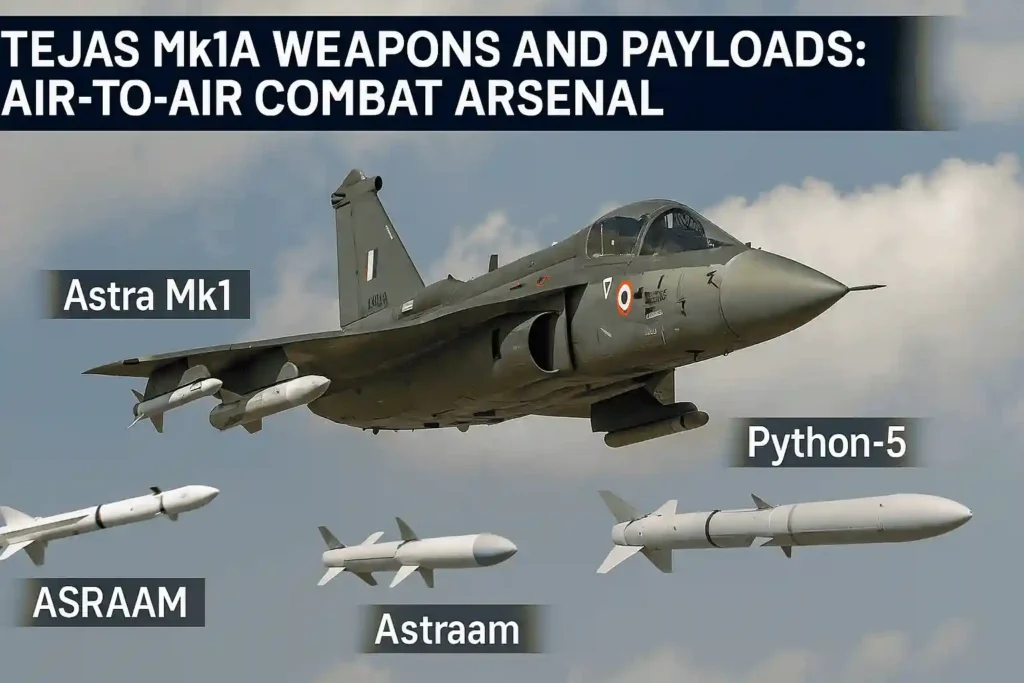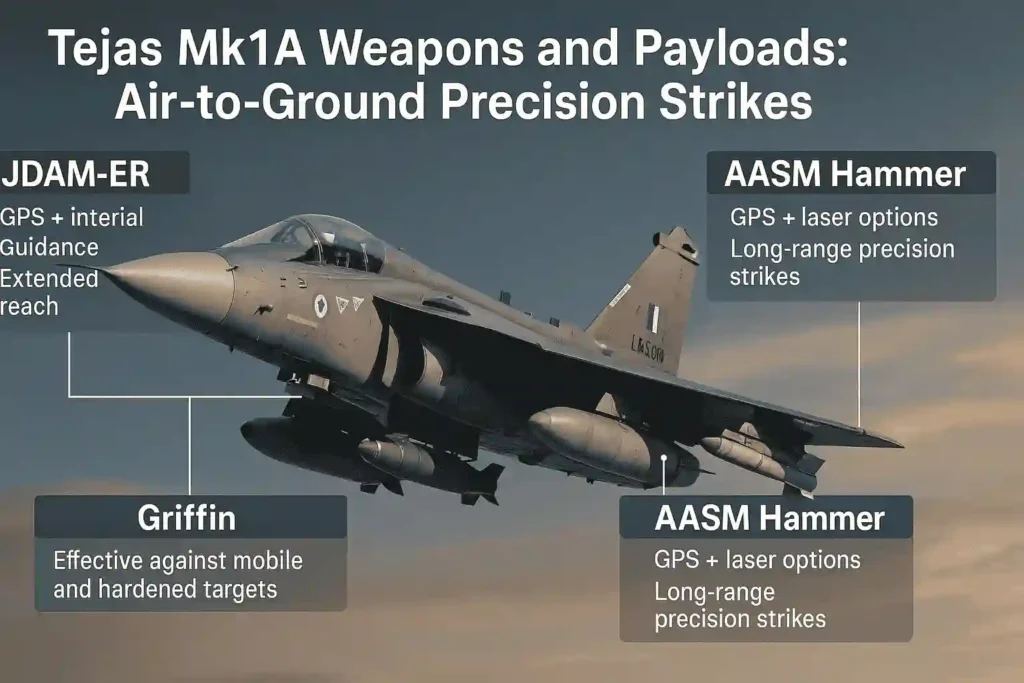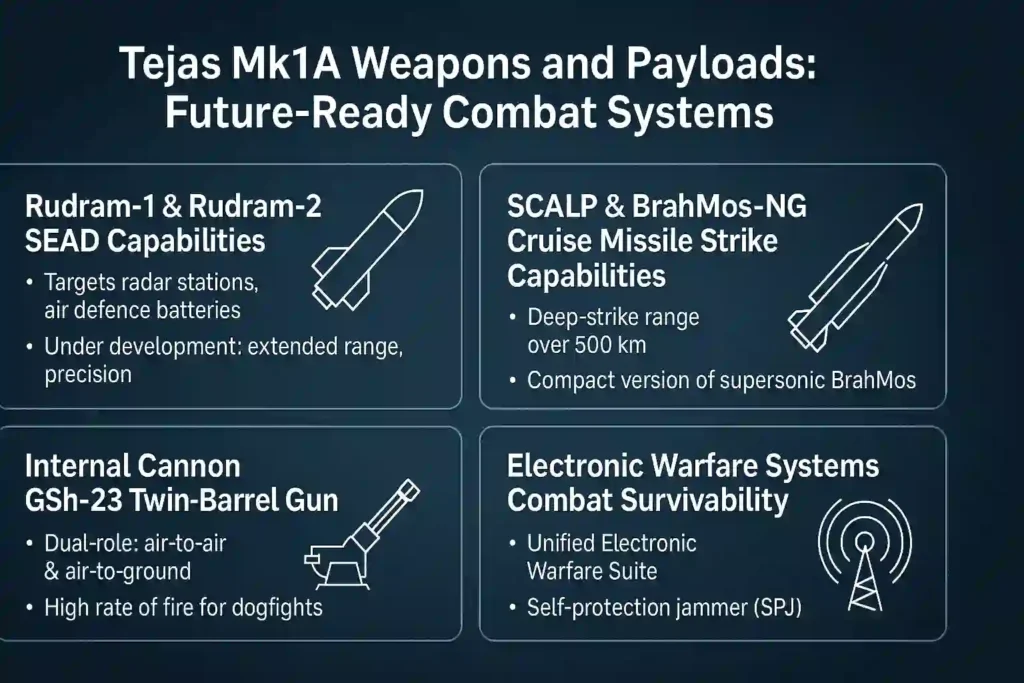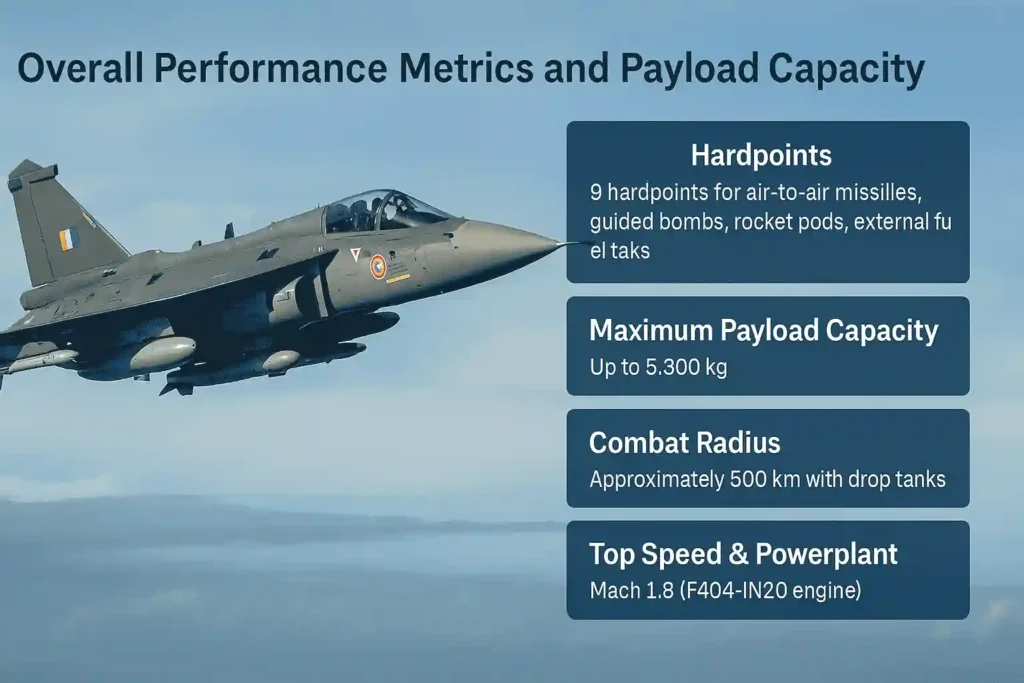The Tejas Mk1A weapons and payloads showcase the best of India’s indigenous fighter capability in 2025. To me, this jet is more than a defence platform. It proves that India can design and field a world-class multirole combat aircraft. Agile, hard to detect, and equipped with advanced digital avionics, it adapts seamlessly between air dominance and precision strike missions.
I have followed its 2025 journey closely: the dual-pylon ASRAAM integration in June, HAL Nashik clearance in August, and now the Meteor and Uttam AESA radar upgrade in September. Together, these milestones place the Mk1A in a new league of airpower.
Tejas Mk1A Weapons and Payloads: Air-to-Air Combat Arsenal

The Tejas Mk1A features an advanced mix of weapons and payloads tailored for diverse mission profiles, including air superiority, ground strikes, and reconnaissance. This flexibility allows the Indian-made fighter to adapt quickly across varied combat scenarios, whether in long-range intercepts or high-speed dogfights.
Air-to-Air Engagements: Key Missiles on Tejas Mk1A
The Tejas Mk1A weapons and payloads include a balanced set of air-to-air missiles for both Beyond Visual Range (BVR) and Within Visual Range (WVR) combat.
Astra Mk1 – India’s Long-Range BVR Missile
- Range: Up to 100 km
- Guidance: Inertial navigation + active radar homing
- Targets: Supersonic aircraft in evasive flight
The Astra Mk1 allows Tejas to strike from stand-off ranges, enhancing pilot survivability and securing air superiority.
ASRAAM – Short-Range Dogfight Missile
- Range: ~25 km
- Seeker: Imaging IR + ECCM
- Integration: Dual-pylon (June 2025), enabling 4 missiles
This upgrade doubled the Mk1A’s dogfight capacity without reducing other payload options.
Python-5 – 360° Engagement Missile
- Range: Up to 20 km
- Seeker: Dual-band IR + EO
- Capability: Lock-on after launch, over-the-shoulder shots
The Python-5 ensures precision and agility in close combat.
Meteor Missile – Game-Changer for Future Batches
- Range: Extended no-escape zone with ramjet propulsion
- Advantage: Outperforms all current BVR missiles in South Asia
- Status: Confirmed for future Mk1A batches (Sept 2025)
Paired with the Uttam AESA radar, the Meteor transforms Tejas Mk1A into a true air-superiority fighter with first-look, first-shot capability.
Tejas Mk1A Weapons and Payloads: Air-to-Ground Precision Strikes

Air-to-Ground Precision Strike Capability of Tejas Mk1A
The Tejas Mk1A is equally lethal in precision strike missions, enabled by targeting pods and guided bombs.
JDAM-ER – GPS-Guided Standoff Bombs
- Range: 70+ km
- Guidance: GPS + inertial navigation
- Targets: Bunkers, command centres, bridges
Provides standoff strike power without entering dense air defences.
Griffin Laser-Guided Bombs
- Target Profile: Armoured vehicles, bunkers, static defences
- Seeker: Semi-active laser
- Use Case: Urban & counter-insurgency missions
Ensures pinpoint accuracy with minimal collateral damage.
AASM Hammer – Modular Glide Bomb
- Range: Up to 60 km
- Guidance: Inertial + GPS; optional laser seeker
- Modularity: Configurable with multiple warheads
Boosts Tejas’ strike effectiveness even in GPS-denied environments.
Tejas Mk1A Weapons and Payloads: Future-Ready Combat Systems

Tejas Mk1A Weapons and Payloads: Future Integrations
The Mk1A continues to evolve with next-gen integrations to keep pace with modern threats.
Rudram-1 & Rudram-2 – SEAD Missiles
- Rudram-1: Targets radars, air defences, emitters
- Rudram-2: Longer range + better guidance for mobile systems
Strengthens Tejas’ role in Suppression of Enemy Air Defences (SEAD).
Meteor + Uttam AESA Radar – Air Superiority Leap
- Meteor: Longest-range BVR missile with ramjet propulsion
- Uttam AESA Radar: Multi-target tracking, EW resistance, long-range situational awareness
- Roll-Out: To equip later Mk1A batches, while earlier ones may use EL/M-2052 radar until Uttam is fully certified
Together, they give Tejas combat parity with global 4.5-gen fighters.
SCALP & BrahMos-NG – Strategic Cruise Missiles
- SCALP: 500+ km deep-strike subsonic missile
- BrahMos-NG: Compact supersonic missile for land & naval targets
Expands Tejas’ regional strike depth and maritime strike power.
GSh-23 Internal Cannon
- Calibre: Twin-barrel 23mm cannon
- Role: Dogfights & low-altitude strafing
Provides last-resort close combat utility.
Electronic Warfare Systems
- Unified EW Suite (UEWS): Threat warning, jamming, automated countermeasures
- Self-Protection Jammer (SPJ): External pod for radar disruption
Ensures survivability in contested airspace.
Overall Performance Metrics and Payload Capacity

Tejas Mk1A: Performance & Payload Specifications
Hardpoints: 9, supporting missiles, bombs, pods, and fuel tanks
Payload Capacity: Up to 5,300 kg
Combat Radius: ~500 km with drop tanks
Top Speed: Mach 1.8
Engine: GE F404-IN20 turbofan
These figures make Tejas Mk1A a balanced mix of agility, firepower, and endurance.
Why It Matters
These specifications make the Tejas Mk1A’s weapons suite both diverse and mission-effective, advancing India’s vision of a nimble, self-reliant, and lethal air fleet.
Conclusion: The Future of the Tejas Mk1A
The Tejas Mk1A, with its mix of Astra Mk1 BVR missiles, JDAM-ER, Griffin bombs, and Rudram SEAD weapons, reflects India’s progress toward a versatile and indigenous fighter fleet. Future payloads like SCALP and BrahMos-NG will expand their strategic strike role, while EW suites ensure survivability in contested skies.
Most importantly, as reported by IDRW (Sept 2025), the integration of the Meteor missile and Uttam AESA radar will transform upcoming Mk1A batches into true air-superiority fighters, giving India a first-shot advantage and reinforcing its Atmanirbhar Bharat vision.
